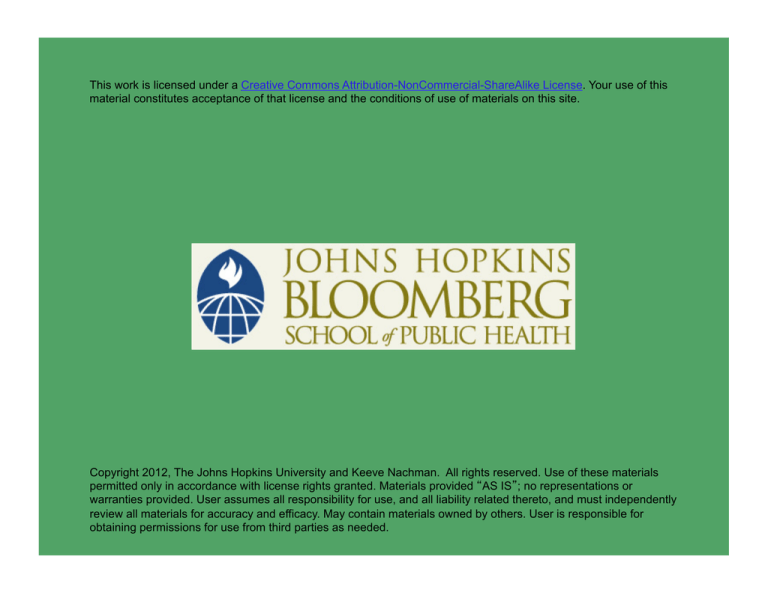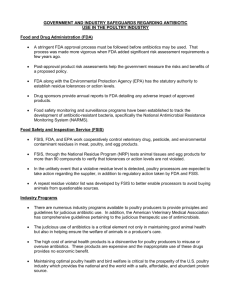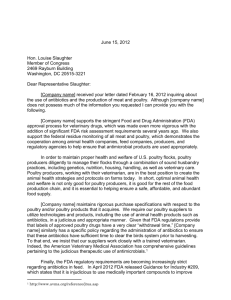
This work is licensed under a Creative Commons Attribution-NonCommercial-ShareAlike License. Your use of this
material constitutes acceptance of that license and the conditions of use of materials on this site.
Copyright 2012, The Johns Hopkins University and Keeve Nachman. All rights reserved. Use of these materials
permitted only in accordance with license rights granted. Materials provided “AS IS”; no representations or
warranties provided. User assumes all responsibility for use, and all liability related thereto, and must independently
review all materials for accuracy and efficacy. May contain materials owned by others. User is responsible for
obtaining permissions for use from third parties as needed.
Section D
Arsenical Drugs in Food Animal Production
Copyright © 2012 Johns Hopkins University and Keeve Nachman. Creative Commons Attribution-NonCommercial-ShareAlike License 3.0.
Overview
n
Arsenical drugs in animal production
n
Human exposures and risks
n
Regulatory and legislative efforts
n
Successes, failures and progress
3
Arsenical Drugs
n
Roxarsone
-
n
n
n
Also p-arsanilic acid, nitarsone,
carbarsone, arsanilate sodium
Additive in poultry and swine feed since the
mid-1940s
Approved for growth promotion, improved
pigmentation, coccidiostat, treatment of
swine dysentery
In poultry production: 88 percent raised
using roxarsone
-
-
2010 estimate
2012 to ?
n
In swine and turkey production: unknown
percentage
n
Single domestic producer
4
Background and Historical Context
n
1944: FDA new animal drug (NADA) 7-891 approval for roxarsone
n
1951: Tolerance levels set by FDA for arsenic residues in meat
products (21 CFR §556.60)
-
-
2 ppm in liver
0.5 ppm in uncooked meat
n
1981: Environmental impact analysis (for FDA)
- “The only probable adverse effect on the human population
arising from the use of 3-nitro premixes (roxarsone) in poultry
and swine feeds is the residues of the compound which may be
present in the food of man”
n
1983: NRC develops approach to chemical-risk assessment
5
The Roxarsone Story
Image deleted because JHSPH OpenCourseWare could
not secure permission for its use.
6
Inorganic Arsenic-Related Health Effects
n
Arsenic is a well-characterized
human carcinogen
-
-
-
n
Noncancer health effects
-
-
-
-
Lung, bladder, skin
Other sites
Transplacental carcinogen
-
-
-
-
-
n
Source: CDC
Cardiovascular disease
Diabetes mellitus
Dermal effects
Neurological effects/
deficits
Immunologic effects
Fertility effects
Birth defects
Respiratory effects
Renal effects
Acute toxicity
- Irritation of lungs, throat,
stomach, intestines, and
skin
7
Gaps in Knowledge/Remaining Questions
n
Chicken meat
-
n
Arsenic type?
Environmental impact
-
Approximately 11 tons per year, but where does it go?
8
The Roxarsone Story: 2011 and Beyond
n
June 8: FDA announcement and Pfizer suspension also announced
-
Press and stakeholder calls
n
July 8: Pfizer suspends marketing of roxarsone in the US
n
August 29: Poultry industry trade groups send letter to Margaret
Hamburg/FDA
n
October 13: Zhejiang Rongyao Chemical Co. files a lawsuit ($20
million) against Pfizer over roxarsone
- January 2011 contract
9
Regulatory Agencies/Mechanisms
n
Use of roxarsone creates environmental public health issues that
extend beyond the jurisdiction of any single federal agency
-
n
Drugs, environmental exposures, food production, food safety,
occupational exposures
Existing regulatory mechanisms that may address some of these
issues are often inadequate
10
Regulatory Agencies/Mechanisms
n
No existing standards addressing arsenic in animal waste
n
No indication of further FDA action based on re-evaluation of
arsenicals
n
So, legislative intervention?
11
Federal and State Legislative Initiatives
n
Federal bill (introduced by Rep. Steve
Israel [D-NY])—the “Poison-free
Poultry Act”
-
-
HR 3264 (2009–2010)
No vote
HR 1487 (2011–2012)
12
Federal and State Legislative Initiatives
n
Maryland bills
-
2010/2011
HB953/HB754 introduced by Del. Thomas Hucker
- No vote/no decision
SB859/SB417 introduced by Sen. Paul Pinsky
-
-
No motion taken/no vote
2012
HB167 introduced by Del. Thomas Hucker
SB207 introduced by Sen. Paul Pinsky
13
Why Was This Year Different?
n
The state of knowledge has changed
-
-
n
FDA study
Harry Hughes Center for Agroecology’s December 2011 report
State of public knowledge and intensity of advocacy coalition/
organizing
14
2012: Success! (Sort of … )
Source: Washington Post. (2012). Copyright © 2012 Washington Post. All Rights Reserved.
15
Success?
16
Loophole?
Roxarsone
(BANNED)
Nitarsone
(EXEMPTED)
17
Next Up: New York
18
Conclusions
n
A lack of meaningful regulatory action
n
Maryland—a good first step, but we aren’t there
n
Other states could follow through
n
Eventual momentum for federal initiative
19
Wrap-Up
n
Production of animals for food has changed drastically over the past
fifty years
n
Current production methods pose serious risks to humans and
environmental quality
n
Fence line communities and animal house workers bear the brunt of
these risks
20








